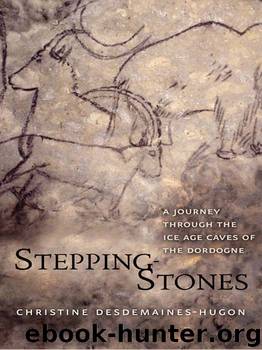Stepping-Stones by Christine Desdemaines-Hugon

Author:Christine Desdemaines-Hugon [Desdemaines-Hugon, Christine]
Language: eng
Format: epub
ISBN: 978-0-300-15266-1
Publisher: Yale University Press (Ignition)
Published: 2010-04-01T16:00:00+00:00
The train moves back to the junction, taking the left fork this time, the one leading to the Great Ceiling. Just at the fork, on the ceiling above the protruding, pillarlike junction wall, is a large rhinoceros, magnificently engraved but inconveniently situated and therefore not shown to the public. But it is important to know that it’s there, in such an obviously strategic position in the cave. Another is next to it, crude and clumsy in comparison. Were these depicted by different artists or were they deliberately differentiated, like the mammoth “couples” seen so far?
As soon as we make our way along the main gallery again, we see that the compacted clay floor is riddled with large circular pits—up to 2 meters wide and 1 meter deep—that were dug out by a much older inhabitant of the cave: the ancient cave bear. These huge bears came in to hibernate, leaving their lairs by the hundreds — and leaving millions of claw marks throughout the cave—until their extinction about 23,000 years ago. For the Paleolithic artists, these pits made their venture even more difficult, as they do for those of us exploring areas off the beaten track today.
The ceiling is lower, the space becomes more confined, and very soon the artists would have had to crawl. A trench has been dug for the train to pass and to ensure the preservation of the drawings and engravings, now out of reach, which is why visitors are allowed to come this far. I’m particularly fond of a group of mammoths on the right, which I’ve secretly named the “family of five”: two adults on the right face two on the left, and in between is a young mammoth, perhaps a baby. In this group the left-hand figures are the most detailed, especially the one closest to the central “baby.” This adult is engraved with an elegant, flowing line for the back, tusks, and trunk, the tip of which is curled; the rest of the body is shaped by abundant hair lines. The wall surface is soft here. A continuous, meandering four-finger digital sign crosses this mammoth diagonally from the top of the head down to beyond the belly and is prolonged by another one flowing around the top of the head down to the curve of the tusks; it may be the same sign continued. The mammoth’s back line is crossed by more of these finger markings. The animal and the signs were probably accomplished simultaneously, as the latter are both on top of and underneath the animal. Furthermore, the mammoths on the left have several deeply gouged markings grouped in the centers of their bodies, just like those on the “patriarch.”
The mammoths on the right are badly damaged, but one can still see that they were initially less detailed. They even look more clumsily done than the others. I have no doubt, though, that they were engraved by the same artist, as the group forms a balanced composition of five figures. There
Download
This site does not store any files on its server. We only index and link to content provided by other sites. Please contact the content providers to delete copyright contents if any and email us, we'll remove relevant links or contents immediately.
The Daily Stoic by Holiday Ryan & Hanselman Stephen(2708)
The Fate of Rome: Climate, Disease, and the End of an Empire (The Princeton History of the Ancient World) by Kyle Harper(2436)
People of the Earth: An Introduction to World Prehistory by Dr. Brian Fagan & Nadia Durrani(2346)
Ancient Worlds by Michael Scott(2102)
Babylon's Ark by Lawrence Anthony(2070)
Foreign Devils on the Silk Road: The Search for the Lost Treasures of Central Asia by Peter Hopkirk(2056)
India's Ancient Past by R.S. Sharma(1987)
MOSES THE EGYPTIAN by Jan Assmann(1972)
The Complete Dead Sea Scrolls in English (7th Edition) (Penguin Classics) by Geza Vermes(1840)
Lost Technologies of Ancient Egypt by Christopher Dunn(1797)
The Daily Stoic by Ryan Holiday & Stephen Hanselman(1768)
The Earth Chronicles Handbook by Zecharia Sitchin(1744)
24 Hours in Ancient Rome by Philip Matyszak(1677)
Alexander the Great by Philip Freeman(1647)
Aztec by Gary Jennings(1545)
The Nine Waves of Creation by Carl Johan Calleman(1520)
Curse Tablets and Binding Spells from the Ancient World by Gager John G.;(1510)
Before Atlantis by Frank Joseph(1483)
Earthmare: The Lost Book of Wars by Cergat(1466)
